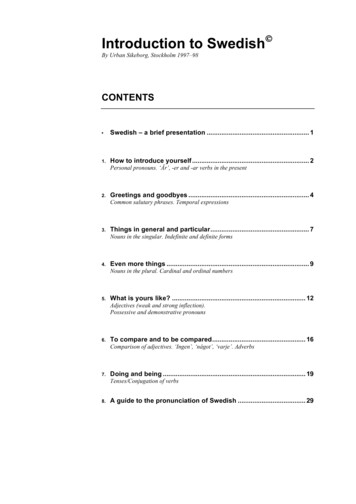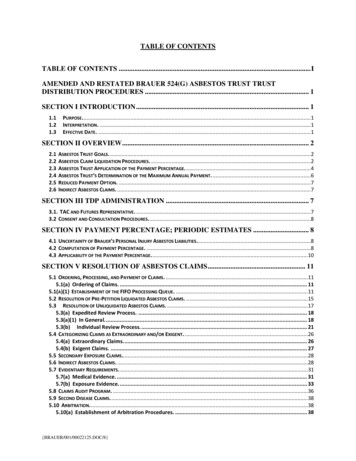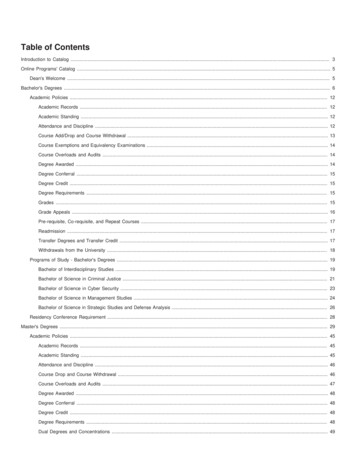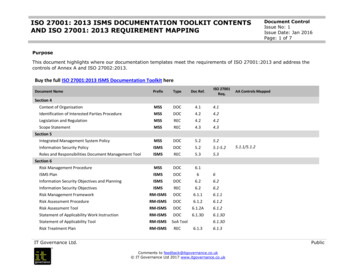
Transcription
Introduction to SwedishÓBy Urban Sikeborg, Stockholm 1997–98CONTENTS Swedish – a brief presentation . 11.How to introduce yourself . 2Personal pronouns. ‘Är’, -er and -ar verbs in the present2.Greetings and goodbyes . 4Common salutary phrases. Temporal expressions3.Things in general and particular . 7Nouns in the singular. Indefinite and definite forms4.Even more things . 9Nouns in the plural. Cardinal and ordinal numbers5.What is yours like? . 12Adjectives (weak and strong inflection).Possessive and demonstrative pronouns6.To compare and to be compared . 16Comparison of adjectives. ‘Ingen’, ‘något’, ‘varje’. Adverbs7.Doing and being . 19Tenses/Conjugation of verbs8.A guide to the pronunciation of Swedish . 29
INTRODUCTION TOSWEDISHBY URBAN SIKEBORGSTOCKHOLM 1997 Swedish is a fascinating and expressive language. It is also a melodic language, admittedly difficultto pronounce like a native because of its characteristic sing-song rhythm, but otherwise not morecomplicated to learn than English. Most Swedes born after World War II do speak or understandEnglish – many of them very well, actually – and you will probably be able to have a memorable andenjoyable stay in Sweden without any deeper knowledge of Swedish. But you will find that just a fewwords of Swedish will work as a wonderful door-key to the Swedes, who have a reputation of beingrather reserved to strangers. Addressing someone in his or her native language is a matter of respect, away of showing that you play by their rules, so to speak. To learn a language means to learn tounderstand the culture where it is spoken and the people who speak it. In a way, to learn a languageopens up a new world.Swedish is a member of the Indo-European family, to which belong almost all European languages(with the exception of the Finnish-Ugrian, Basque, and Caucasian languages), and has many featuresin common with all of these. Its closest relatives are Danish, Norwegian, and Icelandic. The latter hasdue to its isolation remained remarkably intact from the Viking Age and therefore is very difficult tounderstand for other Nordic speakers. Swedes, Norwegians, and Danes usually do not have anydifficulties in communicating with each other. Even though Danish is slightly more closely related toSwedish than Norwegian, its ”hot-potato-in-the-mouth” pronunciation is the main obstacle whenDanes and Swedes speak with each other, whereas Norwegian in that respect is very similar toSwedish. All in all, the differences between the languages are not very big – most Swedes wouldprobably even find it difficult to tell whether a text was written in Norwegian or Danish. SinceSwedish also is the second official language of Finland, a basic knowledge of Swedish will thusenable you to understand and make yourself understood in several countries.There is no natural language which does not require years of study to master completely, but youwill soon acquire an impressive passive vocabulary. You will find that signs and headlines becomemore and more comprehensible and that you within short will be able to browse through a Swedishnewspaper and get a good grasp of what is said. Learning Swedish is facilitated by the fact that overthe centuries it has borrowed thousands of words from Low German, French, and English; some verycommon words in English have in turn been borrowed from the Vikings. This means that many wordswill be familiar to you from the very beginning.But a language is more than just a collection of words; without a basic knowledge of the grammar,your linguistic proficiency will most likely be very limited. This introduction to Swedish presents abrief outline of Swedish grammar, with the emphasis on the spoken, everyday language. It is advisableto browse through the rules for pronunciation in chapter 8 before each chapter. Otherwise you mightend up sending disquietingly like the Swedish Chef in the Muppet Show.1
Chapter 1:How to introduce yourselfSome foreigners have claimed that Swedes in general are rather reserved and stiff in comparison totheir own fellow countrymen. This alleged cultural feature is not a personal quality, however; youwill soon find out that the Swedes are as passionate, wonderful or silly as most other people youknow.SENTENCES TO STUDYHej! Jag héter och kómmer från Vad héter du?Hello! I am called and come from What are called you?Jag héter Iam called Var kómmer du ifrån? / Várifrå n kómmer du?Where come you from? / Wherefrom come you?Jag är från och studérar svenska hä r. Jóbbar du i Stóckhólm?Iam from andstudy Swedish here. Work you in Stockholm?Nej, jag árbétar ínte hä r; jag ä r óckså studént.No,I worknot here; I am too/also student.NOTES1. Personal pronouns‘Jag’ (I) and ‘du’ (you) are pronouns, words denoting persons that perform an action. In English ‘you’ can refereither to one individual or to several persons; in Swedish you use separate forms, depending on the number ofpeople you are addressing. The Swedish so-called personal pronouns are:Personal pronouns:Objective forms:Someone or something that is doing something (”Yousee”)Someone or something that is the object of an action(”I see you”)Singular (referring to one person)jag I1du you(Ni your [polite form])mig/mej mehan he2hon she3den ithónom himdet itdet itdig/dej you(Er you [polite form])hénne herden itPlural (referring to two or more people)vi weoss usni you(Ni you [polite form])4de (‘dom’) theyer you(Er you [polite form])4dem (‘dom’) them1. Swedes usually address each other with the pronoun ‘du’, regardless of what position they might have or ifthey meet for the first time; in fact, the formal ‘Ni’ are nowadays considered old-fashioned and is mainly used2
when talking to older people. The English habit of frequently inserting the name of the person you are talkingto is not common in Swedish and can sometimes be felt too intimate.2. The ‘o’ in ‘hon’ is pronounced like ‘oo’ in ‘good’.3. There are two words for ‘it’ in Swedish. This is because Swedish, unlike English, still define animals andthings in terms of gender, and is in this respect similar to the German with its ‘der, die, das’ and the French‘le, la’. Whether one should use ‘den’ or ‘det’ is decided by what gender the word it refers to has. In thegeneral and neutral meaning ‘it’ has in phrases like ‘it is cold today’, ‘det’ is used: ‘Det ä r kallt idág.’4. The words for ‘they’ and ‘them’ is normally spelled ‘de’ and ‘dem’ respectively, but are almost alwayspronounced ‘dom’.2. Verbs – Doing-or-Being Words‘Heter’, ‘kommer’, ‘är’, ‘studerar’, ‘jobbar’ and ‘arbetar’ are verbs, words that show what someone/something isor does or what is happening. While English has two different endings for regular verbs depending on who isperforming the action – I read, you read, but he/she/it reads – Swedish very conveniently uses only one form,regardless of person: Jag kómmer, du kómmer, hon kómmer, vi kommer etc. Most regular verbs use the ending er, -ar or -r when they are in the present tense, that is describe an action taking place now: ‘hon studérar’ ‘shestudies/is studying’.3. Från/Ifrån‘Från’ is usually changed to ‘ifrå n’ (literally ‘in-from’) when it stands after the word it is referring to or at theend of a clause or a sentence.3
Some countries and parts of the world with their names in SwedishRead more about the pronunciation of Swedish in Chapter 8!4AfricaÁfrikaIranIránAmericaAmérika iaAustrálienItalyItálienAustriaÖ sterríkeJapanJápanBelgiumBélgien [with a 'hard' g]LatviaLéttlandBosniaBósnienLithuaniaLitaúen [the accent on thediphthong umaniaRumä andSkóttlandEngland,Great BritainÉngland, StórbritánnienSerbiaSérbienEstoniaE vénienFranceFránkrikeSouth ceGréklandSwedenSvérige [pronounced as if itsSwedish spelling were'Svérje']Holland, theNetherlandsHólland, Néderlä ndernaSwitzerlandSchweíz [the diphthong ispronounced with an 'e' sound,not as in German]HungaryÚngernThailandThaíland [the stress on thediphthong 'ai', like inEnglish]IcelandÍslandTurkeyTurkíetIndiaÍndien
Chapter 2:Greetings and goodbyesIt has been said that the first impressions last. If that is true, it may be valuable to know how to greetsomebody in a proper way (Swedes are not, for instance, very given to cheek-kissing). Here is a listof some salutary phrases in Swedish. Try to find a couple you think could be useful and memorizethem.SALUTARY PHRASESHej!This is the most common way of greeting someone, be it in aformal or informal situation, and can be used as an equivalent of‘How do you do’ as well as ‘Hi (there)’.Tjéna[re]!Informal and friendly. Actually an abbreviation of 17th and 18thcentury phrases like ‘Jag förbliver Eder ödmjukaste tjänare’ (Iremain your most humble servant).Tja!Very informal and cool. An abbreviated form of ‘tjenare’, oftenin combination with ‘ba’ (‘tjá’ba’), a reduced form of ‘bara’(only), which in Swedish can be used like the English ‘sort/kindof’ as a filler without a real meaning.God mórgon!Used in both formal and informal situations.Good morning!God dag!Good day!God kväll!Good evening!This equivalent to ‘How do you do’ is mostly used to people youcall ‘Ni’, e.g. elderly people, and on formal occasions.The Swedish ‘good evening’ salute is nowadays mainly reservedfor somewhat formal meetings or to people you address with the‘Ni’ pronoun. The synonymous expression ‘God afton’ is ratherantiquated by now.NOTE‘Tj’ is pronounced a bit sharper than the English ‘sh’ sound – as in ‘shut’, but with the middle part of the tonguepressed more towards the palate (cp. German ‘ch’ in ‘ich’).If you just have been introduced to someone you might add:Trévligt att rå kas!Nice to meet [you]!Ángenä mt!Pleasant/nice [to meet you]!Demonstrating that you are a polite and well-behaved person.This equivalent to German ‘Angenehm’ and French ‘Enchanté’ isdefinitely old-fashioned, but could be popular among matureladies.5
NOTELike in English some consonants change sound when they are followed by certain vowels (café - city; guest gist). These so-called soft vowels are in Swedish: e, i y, ä, ö. The ‘g’ in ‘angenämt’, which preceeds the soft vowel‘e’, is therefore pronounced like ‘y’ in ‘yes’, not like ‘g’ in ‘good’. Read more about the rules for pronounciationin chapter 8!If you know the person in question you can ask:Hur står det till?How stands it to?Has got a slightly formal touch, but can also be used in informalsituations.Hur är det?Informal, very common.How is it?Hur har du det?How have you it?Hur är lä get?Hos is the situation?Lä get?Informal, very frequent.A bit more informal, very common.The situation?An abbreviated and more informal form of ”Hur är läget?”. Acommon combination is: ”Tjá’ba! Läget?”Hur går det?Could refer to life in general, but also to a specific task or job.How goes it?Hur mår du?How feel you?Showing concern, focusing on the health/well-being of somebody.Hur är det med [famíljen]?Showing more personal interest when including someone else.How is it with [the family]?Suitable answersTack, [bára] bra!Thanks, [just/only] fine!Very common. Can be used no matter how you feel Skápligt / HýfsatFairly well / DecentWith the Swedish avoidance of superlatives. Quite frequent.Så där / Det kúnde vára bä ttre.So there / It could be betterTwo variants of the same theme: ”Not very well, but I’ll survive”.Ínte så bra, tyvä rr.Not so good, unfortunately.(You are expected to show genuine concern when somebody tellsyou this.)How to say goodbye Hej då!Hello then!Very common, can be used anywhere.Adjö !Formal, dismissive. When used alone equivalent to ‘good day’.Adjö så lä nge!More informal than just ‘adjö’: ‘goodbye for now’, ‘so long’.God natt!Informal, very frequent.Good night!Farvä l!Farewell!6Outmoded, often used in a melodramatic way.
Ha det så bra!Have it soo good!Vi ses:We see [each other]: Informal, very common, like ‘take care’. Often in combinationwith ‘hej då’.See you!sénarelater i mórgonin morning [i.e. tomorrow] i kvällin evening [i.e. tonight] snartsoon om en stundin a while nästa véckanext week på må ndag / tísdag / ónsdag / tórsdag/frédag / lö rdag / sö ndagon Monday/Tuesday etc.7
Chapter 3:Things in general and particularPractically nothing is left in English of the rich inflection of words that characterized the prehistoricancestor of the Indo-European family. Traces of this ancient and very complex system of showingthe exact meaning of a word in a sentence by changing its endings are still preserved in manyformations in related languages, to some extent also in Swedish. This can be seen in how nouns, i.e.naming words (denoting persons, animals, things, material, and abstracts, like house, love, and dog)are treated. To use the correct forms of a Swedish noun you need to know the answers to the followingquestions: GenderIs the word an en word or an ett word? Indefinite or definiteDoes the word denote something in general (indefinite form: ‘a bus’, any bus) or someone or somethingspecific (definite form: ‘the/this bus’)? Number: Singular or
Even though Danish is slightly more closely related to Swedish than Norwegian, its ”hot-potato-in-the-mouth” pronunciation is the main obstacle when Danes and Swedes speak with each other, whereas Norwegian in that respect is very similar to Swedish. All in all, the differences between the languages are not very big – most Swedes would probably even find it difficult to tell whether a .











